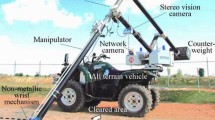Abstract
A reliable communication link between a supervisory computer and a mobile robot is essential for achieving various mission goals, especially those related to hazardous and explosive material handling. Coaxial copper and fiber-optic cable proved to be much more reliable than aerial communication links. Aerial communication used with explosive disposal robots allows for possible terrorist interference making cable communication a requirement. The main problem in using a cable is that it has to be carefully paid out and stacked on the winding spool when the vehicle is moving from/towards the operator. Clearly, the cable can not be dragged by the robot since the typical radius of a mobile robot is 200 to 500 m. Therefore, building a winding system capable of performing smooth and neat cable winding and pay-out operation is crucial for the overall robot reliability. Unfortunately, research in the area of mobile robotic systems has traditionally been focused elsewhere. For this reason a winding system was developed conceptually, and a prototype was built. Hundreds of experiments were performed before completing the work. The developed prototype has unique features including: (i) full independence of the robot control/sensorial system, that is, it is autonomous with respect to the vehicle carrying it; (ii) handling different cables without any readjustment of the control system; and (iii) a sophisticated safety system to prevent irregular cable handling. The paper includes the description of the developed prototype, the underlying conceptual ideas, as well as experimental results.
Similar content being viewed by others
Explore related subjects
Discover the latest articles, news and stories from top researchers in related subjects.References
Delis, James Socrates 1993. Design considerations, machinery and control options in coil winding.IEEE Electrical Insulation Magazine, 9(4):16–22.
Hung, John Y. and Van White, H. 1992. Precision winding of fiber optic filament—Part 1: Winding characteristics.IEEE Transactions on Industrial Electronics, 39(3):258–267.
Hung, John Y. and Van White, H. 1992b. Precision winding of fiber optic filament—Part 1: Winding characteristics.IEEE Transactions on Industrial Electronics, 39(4):313–322.
Huston, Ronald L. and Kamman, James W. 1982. Validation of finite segment cable models.Computers and Structures, 15(6):653–660.
Puttre, Michael, 1993, Undaunted dante readies for inferno, mechanical engineering, 115(12):58–59.
Roser, R. 1990. Filament winding.Modern Plastics, 66(11):309–310.
Spur, G. and Wambach, R. 1991. Drive control for cable winding, wire. 41(4):326–333.
Welp, Ewald G. 1992. Winding high grade printing and technical papers.Paper Technology and Industry, 33(7):10–15.
Winget, J. M. and Huston, R. 1975. Cable dynamics—A finite segment approach.Computers and Structures, 33(7):475–480.
Author information
Authors and Affiliations
Rights and permissions
About this article
Cite this article
Kircanski, N.M., Goldenberg, A.A. & Dickie, S.K. An autonomous cable winding and pay-out system for mobile robots. Auton Robot 2, 237–253 (1995). https://doi.org/10.1007/BF00710859
Issue Date:
DOI: https://doi.org/10.1007/BF00710859




